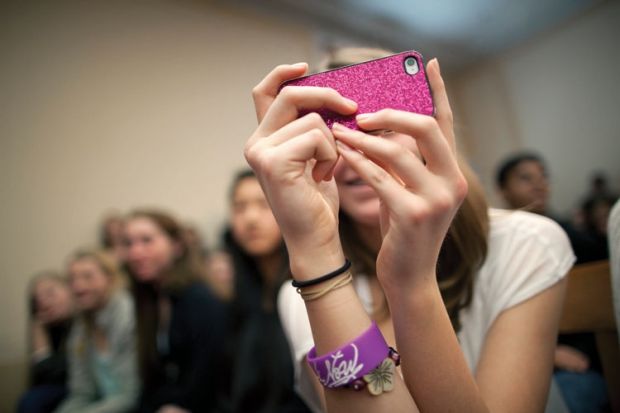By Carl Straumsheim, for Inside Higher Ed
In “Mobile phones in the classroom: Examining the effects of texting, Twitter and message content on student learning”, Jeffrey H. Kuznekoff, assistant professor in the department of integrative studies at Miami University (Ohio) at Middletown, explores if texting, tweeting and note-taking can be combined.
The article appears in the most recent edition of Communication Education, a journal of the National Communication Association.
On one hand, studies show that students who text and hang out on social media during class are less likely to remember details about lectures and more likely to earn a lower grade than students who pay attention. On the other hand, research also suggests that students who take notes during lectures score higher than those who don’t.
Kuznekoff’s research is an attempt to find a role – if one exists – for smartphones and other devices in the classroom. While some faculty members have banned them outright, saying they disrupt lectures and derail students’ attention, others, like Kuznekoff, are experimenting with using the devices to improve knowledge retention.
“Having the student bring their own device and use [it] in a meaningful way that connects to the content is something we should be exploring,” Kuznekoff said in an interview. “It’s a losing battle to try to fight that.”
Kuznekoff's study involved 145 randomly selected undergraduates in communication classes at a large unnamed university in the Midwest of the US. The students took notes as they watched a 12-minute video lecture on interpersonal communication theories, then had three minutes to review before taking two tests: one where they were asked to recall as much information as possible, the other a 16-question multiple-choice exam.
During the lecture, however, the students were subjected to different distractions on their smartphones. Four groups received fake text messages with content relevant (“What is the name of the theory the professor is talking about now?”) or irrelevant to the lecture (“What is your favorite restaurant for dinner?”). Another four groups were asked to tweet messages related or unrelated to the lecture.
Students in those experimental groups were further separated into smaller groups to see if the frequency of the distractions affected their academic performance – half of the groups received fake messages or prompts to tweet every 60 seconds; the other, every 30 seconds.
Finally, students in a control group put their phones away and focused on the video.
Kuznekoff hypothesised that the students who didn’t glance at their phones would score the highest, followed by those texting and tweeting about the lecture, and then those distracted by texts and tweets unrelated to the class.
The results mostly confirmed that hypothesis: students in the control group scored the equivalent of a letter grade higher than the students texting about topics unrelated to the lecture. Yet students who texted about the contents of the video, regardless of how often they did so, earned scores that were nearly on par with students in the control group.
“They’re still engaging with the content in some fashion, still mentally processing it,” Kuznekoff said. “That appears, in this short-term experiment, to not have a significantly detrimental effect on learning.”
Results from the students asked to tweet were mixed. The control group and the students who tweeted every 60 seconds performed 65 per cent and 53 per cent higher, respectively, than the students who tweeted every 30 seconds.
Kuznekoff said tweeting may be more “cognitively intensive” than texting, and therefore more distracting. Unlike the students who were asked to text, the students using Twitter didn’t receive any prompt they had to respond to. The students also had to navigate Twitter’s 140-character restriction.
Michelle Miller, director of the First Year Learning Initiative at the University College at Northern Arizona University, suggested that students who texted about the lecture performed as well as those not using their phones because the prompts essentially worked as a clicker or flash quiz.
“Perhaps what we’re seeing is yet another manifestation of one of our strongest findings in applied memory research, which is the testing effect and the effect of retrieval practice,” Miller said.
Miller, professor of psychological sciences, explored cognition and how it relates to course design in her book, Minds Online: Teaching Effectively with Technology. She said that faculty members on both sides of the debate about devices in the classroom are likely to find support for their position in Kuznekoff’s study.
“I don’t think [faculty members] can afford to sideline ourselves from these questions about learning and cognition,” Miller said. “This does point out the degree to which all of us are not just bringing our disciplines into the classroom any more. We are all having to be design experts and, to an extent, be conversant in some aspects of learning theory.”




